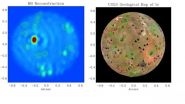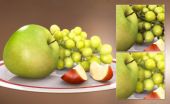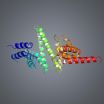'Microcombing' creates stronger, more conductive carbon nanotube films
2015-05-05
(Press-News.org) Researchers from North Carolina State University and China's Suzhou Institute of Nano-Science and Nano-Biotics have developed an inexpensive technique called "microcombing" to align carbon nanotubes (CNTs), which can be used to create large, pure CNT films that are stronger than any previous such films. The technique also improves the electrical conductivity that makes these films attractive for use in electronic and aerospace applications.
"It's a simple process and can create a lightweight CNT film, or 'bucky paper,' that is a meter wide and twice as strong as previous such films - it's even stronger than CNT fibers," says Yuntian Zhu, Distinguished Professor of Materials Science and Engineering at NC State and corresponding author of a paper describing the work.
The researchers begin by growing the CNTs on a conventional substrate in a closely packed array. The CNTs are tangled together, so when researchers pull on one end of the array the CNTs form a continuous ribbon that is only nanometers thick. This ribbon is attached to a spool, which begins winding the ribbon up.
As the spool pulls, the CNT ribbon is dragged between two surgical blades. While the blades appear straight to the naked eye, they actually have micrometer-scale fissures on their cutting edge. These fissures create a kind of "microcomb" that pulls the CNTs into alignment - just as a regular comb sorts through tangled hair.
When the ribbon of aligned CNTs is being wound onto the spool, the researchers apply an alcohol solution. This pulls the CNTs closer together, strengthening the bonds between CNTs.
The CNT ribbon wraps around itself as it winds around the spool, creating a layered film of pure CNTs. Researchers can control the thickness of the film by controlling the number of layers.
The CNT films made using the microcombing technique had more than twice the tensile strength of the uncombed CNT films - greater than 3 gigapascals for the microcombed material, versus less than 1.5 gigapascals for the uncombed material.
The microcombed CNT film also had 80 percent higher electrical conductivity than the uncombed film.
"This is a significant advance, but we want to find ways to make CNT alignment even straighter," Zhu says. "It's still not perfect.
"In addition, the technique would theoretically be easy to scale up for large-scale production. We'd like to find an industry partner to help us scale this up and create a material for the marketplace."
INFORMATION:
The paper, "Strong and Conductive Dry CNT Films by Microcombing," is published online in the journal Small. Lead author of the paper is NC State Ph.D. student Liwen Zhang. Co-authors include Xin Wang, Weizong Xu and Philip Bradford of NC State; and Yongyi Zhang and Qingwen Li of the Suzhou Institute. The work was supported by the Air Force Office of Scientific Research under grant number FA9550-12-1-0088.
[Attachments] See images for this press release:


ELSE PRESS RELEASES FROM THIS DATE:
2015-05-05
Alzheimer's disease (AD) is a neurodegenerative condition that strikes at the heart of what makes us human: the ability to think, to feel, to remember and to communicate with those around us. The tragedy is compounded by the fact that there is currently no cure, no treatment, and no diagnostic method capable of identifying Alzheimer's at its early stages.
A ground-breaking study has now, for the first time anywhere, characterized early-stage changes that occur inside individual, Alzheimer's-affected cells in the intact brain. Remarkably, the study indicates that even ...
2015-05-05
How many websites have you clicked on recently that haven't converted their format to mobile, frustrating your efforts to get the information you need in an effective and timely way?
Now researchers from Northwestern University have unearthed some provocative facts on how consumers utilize their mobile devices to buy groceries. With the global market for smartphones predicted to reach two billion by 2016, their findings should convince retailers planning marketing strategies and advertising campaigns that they need to pay attention to mobile.
In "On the Go: How Mobile ...
2015-05-05
PITTSBURGH (May 5, 2015) ... For decades, robots have advanced the efficiency of human activity. Typically, however, robots are formed from bulky, stiff materials and require connections to external power sources; these features limit their dexterity and mobility. But what if a new material would allow for development of a "soft robot" that could reconfigure its own shape and move using its own internally generated power?
By developing a new computational model, researchers at the University of Pittsburgh's Swanson School of Engineering have designed a synthetic polymer ...
2015-05-05
Treating gum disease reduced symptoms of prostate inflammation, called prostatitis, report researchers from Case Western Reserve University School of Dental Medicine and the Departments of Urology and Pathology at University Hospitals Case Medical Center.
Previous studies have found a link between gum disease and prostatitis, a disease that inflames the gland that produces semen. Inflammation can make urination difficult.
"This study shows that if we treat the gum disease, it can improve the symptoms of prostatitis and the quality of life for those who have the disease," ...
2015-05-05
Although the use of cannabis as a medical drug is currently booming (Dtsch Arztebl Int 2012; 109: 495-501), we should not forget that leisure time consumption--for example, smoking weed--can cause acute and chronic harms. These include panic attacks, impaired coordination of movement, and nausea, as Eva Hoch and colleagues show in a topical review article in Deutsches Ärzteblatt International (Dtsch Arztebl Int 2015; 112: 271-8). The symptoms depend on a patient's age, the amount of the drug consumed, and the frequency of drug use. It also matters in which form the ...
2015-05-05
(Winston-Salem, N.C. - May 5, 2015) - Researchers from Wake Forest University and the University of Utah are the first to successfully fabricate halide organic-inorganic hybrid perovskite field-effect transistors and measure their electrical characteristics at room temperature.
"We designed the structure of these field-effect transistors that allowed us to achieve electrostatic gating of these materials and determine directly their electrical properties," said lead author, Oana Jurchescu, an assistant professor of physics at Wake Forest. "Then we fabricated these transistors ...
2015-05-05
This news release is available in German.
With the first detailed observations of a lava lake on a moon of Jupiter, the Large Binocular Telescope Observatory in Arizona places itself as the forerunner of the next generation of Extremely Large Telescopes. The applied high-resolution imaging methods were developed by an international research team including scientists from the Max Planck Institute for Radio Astronomy in Bonn and the Max Planck Institute for Astronomy in Heidelberg.
Io, the innermost of the four moons of Jupiter discovered by Galileo in January ...
2015-05-05
This news release is available in German.
Overturning cars, flying missiles, and airplanes speeding across the screen -- on modern computers, 3D objects can be calculated in a flash. However, many surfaces still look unnatural. Whether it is skin, stone or wax -- on the computer screen, all materials look alike, as if the objects had all been cut out of the same kind of opaque material. This is about to change: TU Wien (Vienna), the University of Zaragoza and the video game company Activision-Blizzard have developed a new mathematical method which makes surfaces appear ...
2015-05-05
Our view of what makes us happy has changed markedly since 1938.
That is the conclusion of the psychologist Sandie McHugh from the Univeristy of Bolton who has recreated a famous study of happiness conducted in Bolton in 1938. She will present her study today, Tuesday 5 May 2015, to the Annual Conference of the British Psychological Society in Liverpool.
In 1938 Mass Observation placed an advertisement in the the Bolton Evening News asking readers to answer the question 'What is happiness?'. A total of 226 people sent letters in reply, and they were asked to help compile ...
2015-05-05
Ribosomes are vital to the function of all living cells. Using the genetic information from RNA, these large molecular complexes build proteins by linking amino acids together in a specific order. Scientists have known for more than half a century that these cellular machines are themselves made up of about 80 different proteins, called ribosomal proteins, along with several RNA molecules and that these components are added in a particular sequence to construct new ribosomes, but no one has known the mechanism that controls that process.
Now researchers from Caltech and ...
LAST 30 PRESS RELEASES:
[Press-News.org] 'Microcombing' creates stronger, more conductive carbon nanotube films




